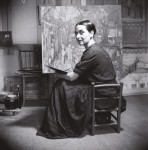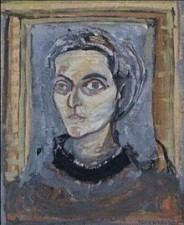
Maria Helena Vieira da Silva
French, 1908-1992
Cité lacustre (Lakeside City), 1957
oil on canvas
31 3/4 × 39 1/4 in.
SBMA, Gift of Robert B. and Mercedes H. Eichholz
2014.17.9

Undated photo of Vieira da Silva in her studio
“When I paint a landscape or a seascape, I’m not very sure it’s a landscape or a seascape. It’s a thought form rather than a realistic form.” - Maria Helena Vieira da Silva
RESEARCH PAPER
Pronunciation of her name
Vieira da Silva is a Portuguese name, pronounced differently from Spanish.
VEE air Ah dah SEAL vah
Looking at the work
We are initially drawn into an expanding space, as if viewed from above. Though abstract in being non-specific, we clearly have the sense of a landscape bearing the marks of human habitation. The juxtaposition of flowing natural earth forms and geometric impositions of linear order suggest a long distance view of some earlier happening. Vieira da Silva was deeply influenced by the destruction with which she was confronted when she returned to Paris after the war.
At the same time the restricted palette, fragmented forms and spatial ambiguity clearly announce her comradeship with Cubism and abstract art. We think of Cézanne’s landscapes breaking into geometric forms, flattening out the surface and denying perspective. These are lessons Vieira da Silva took to heart, and she continued to paint variations on this theme her entire career.
We have seen this work several times before when Mercedes Eichholz loaned it to contemporary exhibitions. I have found it never wears thin, inviting long, quiet viewing as the perspectives shift and depth seems to develop. As with the great American abstract expressionists, Rothko and Pollack, a distance recedes before our eyes, inviting us into the mystery of the surface, now expanding into an unexplored depth.
In the 1981 Tate Modern new acquisition catalogue for Vieira da Silva’s painting The Corridor, 1950, Léon Kochnitzky wrote, “The painter is gripped by a strange anguish, which leads her to a more and more intense contemplation of the infinitesimal, subterranean chambers which diffuse their own light, . . . ” Though he is referring to The Corridor, his comments elucidate our Lakeside City.
She herself comments, “When I paint a landscape or a seascape, I’m not very sure it’s a landscape or a seascape. It’s a thought form rather than a realistic form.”
Biography
Vieira da Silva, recognized as Portugal’s premier 20th c painter, print maker and sculptor, who began her training at eleven and entered Lisbon’s Academia de Belas-Artes, studied painting with Fernand Léger and sculpture with Antoine Bourdelle, moved to Paris to study art at twenty. Two years later she married a Hungarian painter who became her mentor. Except for the WWII years, during which they lived in Brazil, Paris has been her home, recognizing her talent early and ultimately naming her a Chevalier of the Legion of Honor in 1979.
Prepared for the SBMA Docent Council by Ricki Morse, June 2014
Bibliography
Nancy G. Heller, Women Artists: Works from the National Museum of Women in the Arts, Rizzoli, New York, 2000.
Gisela Rosenthal, Vieira da Silva, 1908-1992: The Quest for Unknown Space, Taschen, New York, 2005

Self-portrait by Vieira da Silva, 1942
SBMA CURATORIAL LABELS
Born in Lisbon to an affluent family, Vieira da Silva was exposed to avant-garde art at a young age, seeing the Ballets Russes under the direction of Sergei Diaghilev and also the Italian Futurists. After studying art in Lisbon, she moved to Paris in 1928, then fled France for exile in Brazil during World War II. After returning in 1947, she settled into her distinctive lapidary abstraction with minute marks that cohere into a loose grid that might reference the facades of Lisbon or Paris. Her other tendency is a diaphanous, all-over effect without right angles or straight lines. These feel like a view into a leafy tree, a cloud, or the trembling surface of a lake. This painting’s double title, Lakeside City or Winter in Holland—with its reference to a city and to nature—shows her pulling together cities and human constructions with the natural world. The crosses might reference a street grid or windows, while the lower right has brachial, vine-like forms.
- Going Global, 2022
Maria Helena Vieira da Silva was born in Lisbon, and as a young girl, traveled extensively with her parents (her father was a diplomat). She encountered an array of avant-garde groups, such as the Italian Futurists and the Ballets Russes. In 1928 she moved to Paris, where she continued her formal training in art, and absorbed a variety of influences—from the geometric abstraction of Joaquín Torres-García to the vibrant compositions of Pierre Bonnard.
Vieira da Silva’s early work exhibits a sensitivity to rhythm and pattern that would become a significant component of her mature paintings, in which an atmospheric sense of space is interrupted by jagged shapes. At the outbreak of World War II, she fled with her husband, painter Arpad Szenès, to Rio de Janeiro, where she continued to paint and exhibit until the couple was able to return to Paris in 1947. Vieira da Silva became a French citizen in 1956, and died in Paris in 1992.
Vieira da Silva’s paintings from the 1950s focus on the postwar environment, both natural and constructed: cities that were burned or flooded, alleyways, sunsets, and landscapes. Works such as Cité Lacustre (Lakeside City) blur the specificity of place, suggesting remnants of a grid or rational order that has since disintegrated.
- Colefax Gallery in honor of the Robert and Mercedes Eicholz Collection coming to the museum, June 2014
